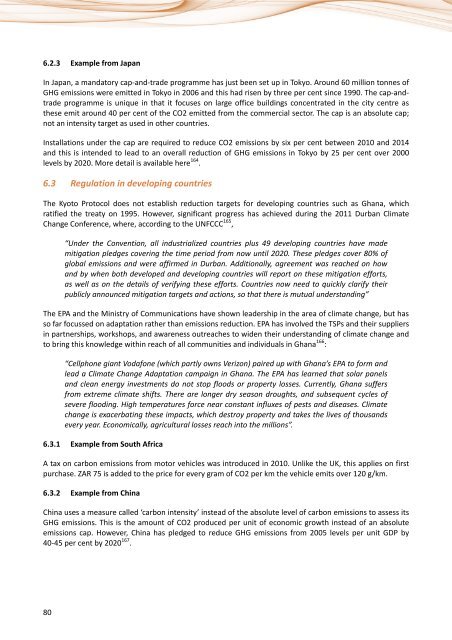Information and communication technologies (ICTs) and ... - ITU
Information and communication technologies (ICTs) and ... - ITU
Information and communication technologies (ICTs) and ... - ITU
Create successful ePaper yourself
Turn your PDF publications into a flip-book with our unique Google optimized e-Paper software.
6.2.3 Example from Japan<br />
In Japan, a m<strong>and</strong>atory cap-<strong>and</strong>-trade programme has just been set up in Tokyo. Around 60 million tonnes of<br />
GHG emissions were emitted in Tokyo in 2006 <strong>and</strong> this had risen by three per cent since 1990. The cap-<strong>and</strong>trade<br />
programme is unique in that it focuses on large office buildings concentrated in the city centre as<br />
these emit around 40 per cent of the CO2 emitted from the commercial sector. The cap is an absolute cap;<br />
not an intensity target as used in other countries.<br />
Installations under the cap are required to reduce CO2 emissions by six per cent between 2010 <strong>and</strong> 2014<br />
<strong>and</strong> this is intended to lead to an overall reduction of GHG emissions in Tokyo by 25 per cent over 2000<br />
levels by 2020. More detail is available here 164 .<br />
6.3 Regulation in developing countries<br />
The Kyoto Protocol does not establish reduction targets for developing countries such as Ghana, which<br />
ratified the treaty on 1995. However, significant progress has achieved during the 2011 Durban Climate<br />
Change Conference, where, according to the UNFCCC 165 ,<br />
“Under the Convention, all industrialized countries plus 49 developing countries have made<br />
mitigation pledges covering the time period from now until 2020. These pledges cover 80% of<br />
global emissions <strong>and</strong> were affirmed in Durban. Additionally, agreement was reached on how<br />
<strong>and</strong> by when both developed <strong>and</strong> developing countries will report on these mitigation efforts,<br />
as well as on the details of verifying these efforts. Countries now need to quickly clarify their<br />
publicly announced mitigation targets <strong>and</strong> actions, so that there is mutual underst<strong>and</strong>ing”<br />
The EPA <strong>and</strong> the Ministry of Communications have shown leadership in the area of climate change, but has<br />
so far focussed on adaptation rather than emissions reduction. EPA has involved the TSPs <strong>and</strong> their suppliers<br />
in partnerships, workshops, <strong>and</strong> awareness outreaches to widen their underst<strong>and</strong>ing of climate change <strong>and</strong><br />
to bring this knowledge within reach of all communities <strong>and</strong> individuals in Ghana 166 :<br />
“Cellphone giant Vodafone (which partly owns Verizon) paired up with Ghana’s EPA to form <strong>and</strong><br />
lead a Climate Change Adaptation campaign in Ghana. The EPA has learned that solar panels<br />
<strong>and</strong> clean energy investments do not stop floods or property losses. Currently, Ghana suffers<br />
from extreme climate shifts. There are longer dry season droughts, <strong>and</strong> subsequent cycles of<br />
severe flooding. High temperatures force near constant influxes of pests <strong>and</strong> diseases. Climate<br />
change is exacerbating these impacts, which destroy property <strong>and</strong> takes the lives of thous<strong>and</strong>s<br />
every year. Economically, agricultural losses reach into the millions”.<br />
6.3.1 Example from South Africa<br />
A tax on carbon emissions from motor vehicles was introduced in 2010. Unlike the UK, this applies on first<br />
purchase. ZAR 75 is added to the price for every gram of CO2 per km the vehicle emits over 120 g/km.<br />
6.3.2 Example from China<br />
China uses a measure called ‘carbon intensity’ instead of the absolute level of carbon emissions to assess its<br />
GHG emissions. This is the amount of CO2 produced per unit of economic growth instead of an absolute<br />
emissions cap. However, China has pledged to reduce GHG emissions from 2005 levels per unit GDP by<br />
40-45 per cent by 2020 167 .<br />
80

















